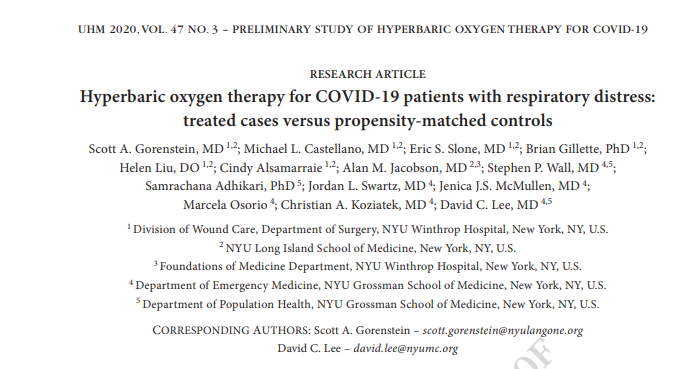The results of a prospective study of hyperbaric oxygen therapy (HBOT) for COVID-19 respiratory distress are available ahead of print in Undersea and Hyperbaric Medicine. Gorenstein and colleagues treated 20 COVID-19 patients with HBOT and used propensity-matched controls to evaluate the results. Patients ranged in age from 30 to 79 years. and had oxygen requirements ranging from 2 to 15 liters. Of the 20 patients treated with HBOT, two (10%) were intubated and died but none of the others remained hospitalized at the completion of the study. By comparison, among the 60 propensity-matched controls (based on age, sex, body mass index, coronary artery disease, troponin, D-dimer, hospital day, and oxygen requirement), 18 (30%) were intubated, 13 (22%) died, and three (5%) remained hospitalized at the end of the study (one on mechanical ventilation). The small size of the study means that the results have to be interpreted with caution, but it shows that HBOT is safe for COVID-19 patients and suggests that a large, prospective trial is needed to assess its possible benefit.
Few treatments are as logical as oxygen for hypoxia, so HBOT makes obvious sense when other methods of oxygen delivery are insufficient. Additionally, HBOT has other beneficial effects on the body’s inflammatory state. Unfortunately, since oxygen is not made by a pharmaceutical company, there is no logical source of funding for the large clinical studies to determine whether this obvious and low-risk intervention could reduce the need for COVID-19 related intubation. And, there’s another longer term worry of COVID-19 infection. According to a recent report by the Centers for Disease Control (CDC), up to 35% of those diagnosed with Covid-19 are not back to their normal selves two to three weeks after testing positive. There is mounting evidence that this Coronavirus can trigger a multisystem inflammatory condition. This may be responsible for the “chronic fatigue like” syndrome some adults describe after a COVID-19 infection. Long-term follow up of HBOT-treated patients is needed to determine whether HBOT could reduce the terrible aftermath experienced by some, and which currently has no treatment.
See also this story about HBOT for COVID-19, by Margie Mason and Robin McDowell of the Associated Press.

Dr. Fife is a world renowned wound care physician dedicated to improving patient outcomes through quality driven care. Please visit my blog at CarolineFifeMD.com and my Youtube channel at https://www.youtube.com/c/carolinefifemd/videos
The opinions, comments, and content expressed or implied in my statements are solely my own and do not necessarily reflect the position or views of Intellicure or any of the boards on which I serve.




HI DR FIFE
I HAVE BEEN TRYING TO RESEARCH THE FOLLOWING
DO YOU KNOW OF ANYONE USING HBOT TO TREAT THE SYMPTOMS OF THE COVID LONG HAULERS MONTHS AFTER THEIR ACUTE COVID ILLNESS?
WHAT IS YOUR OPINION ON THIS
THANKS MATT MCCOOL MD